Globally Applicable
Advanced Spiders
Veljko Milutinovic
Department of Computer Engineering
School of Electrical Engineering
University of Belgrade
vm@etf.rs
http://galeb.etf.rs/~vm
S
Software Agents
The existing tool-based model = the "do what I say" model; mimicing a slave
(a) User initiates actions which are passively facilitated by software
(b) Local interaction (local machine)
The new agent-based model = the "do what I imply" model
(a) Environment initiated actions; mimicing a highly competent secretary
(b) Global interraction (world wide)
Types of software agents:
(a) Static or computer-bound (like office-bound worker)
(b) Dynamic or network-wide (like mobile field workers)
Example of a static agent:
(a) Mail agent responsible for automatic reply
(b) Using embedded knowledge to assist in filtering and processing the volume
Example of a dynamic agent:
(a) Running on a remote node and periodically reporting to the home node
(b) Running hours or days after being unleashed
Typical working scenarios:
(a) Working based on directives
Selling a stock after certain level is reached
(b) Cooperating with other agents
Setting a meeting time, and resetting when a higher level agent comes
Why software agents:
(a) Managing the information overhead (filtering and sorting the input data)
(b) Decision support (expert systems)
(c) Repetitive activity (labor cost contributes significantly to the final price)
(d) Mundane personal activity (booking air tickets)
(d) Search and retreival (to create an output data stream)
(e) Domain experts (making the costly expertise widely available)
Properties of mobile software agents:
(a) Programmability
Must be programmed or instructed in some manner
(b) Safety
Remote hosts must be sure that agent will create no harm of any kind;
the greatest concern (viruses are a kind of agents)
(c) Resourcescarefulness
As an owner,
you must be sure that your agent will not exceed the budget;
as a host,
you must be sure that the visitor will not overuse resources
(d) Navigationability
The agent must be able to find the needed resources
(e) Privacy
The agent's internal program and state should not be visible to others
(f) Communicationability
The agent must be able to communicate with owner,
even if the network is down
What makes an agent intelligent:
(a) Agent independency
(b) Agent learning
(c) Agent cooperation
(d) Agent reasoning (rule-based, knowledge-based, ...)
(e) Smart interface
Components of a software agent:
(a) Owner
Parent process name or master agent name
(b) Author
Templates for customization or contacts for consulting
(c) Lifetime
Death condition
(d) Account
Billing related information or links to owner accounts
(e) Goal
Measure of success
(f) Subject
Description of the goal's attributes
(g) Background
Supporting information in the form understandable by the agent
Launching software agents:
(a) A request is placed to a network resource (e.g., node)
(b) A permission is granted (e.g., access)
Launching technologies:
(a) Synchronous remote procedure call - using a request-reply cycle
(b) Async remote programming - using message-oriented system agents
(c) Database middleware* - using protocols for access to relational databases
Issues:
(a) Controlling an agent on the fly
(b) Protecting an agent on the fly
Some agent oriented languages:
(a) Telescript (postscript)
(b) Safe (active email)
(c) Java (called from an HTML document)
*
junkware
Main categories of software agents:
(a) Event monitors (on condition triggers)
(b) Work flow assistants (on demand advisers)
(c) Internet data gathering and retrieval agents (on-line search spiders)
Application domains:
(a) Broadband/static communications and computing
(b) Wireless/mobile communications and computing

Active Document Architecture (ADA)
Essence of ADA:
(a) ADA enabled by advances in broadband and wireless technologies!
Enabled by the move from PC to PG (personal gateway to the network)
(b) ADA integrates multimedia information from different sources on the network
in a disciplined manner (mixing the applets, ...)
- Three elements of ADA
:
(a) Single process local containers/workspaces
(b) Shared containers/workspaces
(c) Network distributed objects (e.g. CORBA or COM elements, ...)
- Approaches to ADA
:
(a) Single platfrom integration
(b) Multiple platform integration
(c) Object-to-object calling mechanism
Microsoft dynamic data exchange
IBM system object manager
CORBA - Common Object Request Broker Architecture:
ADA in ACTION
Essence:
A specification of a common messaging standard for distributed objects
Four key elements of CORBA:
(a) Object request broker
A language which insulates the client form the comm mechanisms used
(b) Object services
Higher level services - transactions, concurrency control, licencing...
(c) Common facilities
Rules of interaction in four domains:
User interface
Information management
System management
Task management
(d) Application objects
Components of specific end-user applications
- Conclusion:
CORBA is universal plumbing needed to promote e-commerce on I-way!
Genetic Algorithms and Simulated Annealing
for Internet Search
Veljko Milutinovic
Department of Electrical Engineering
School of Electrical Engineering
University of Belgrade
POB 35-54, 11120 Belgrade, Serbia, Yugoslavia
vm@etf.rs
http://galeb.etf.rs/~vm
S
GAAS
Support for links-based search agents (Spiders),
as an alternative to index-based search (Altavista)
Genetic algorithms invented and developed in AI;
may be efficient if properly applied to Internet search
Simulated annealing introduced in mathematics;
applicable to Internet search, but reported as not too efficient
Industry leader in packages for EBI-related strategic planning:
Comshare, Inc.
Genetic Algorithm
for Internet Search
Select the initial WWW presentation or a set thereof
Extract all URLs and fetch the corresponding WWW presentations
Measure the fitness value for each newly fetched WWW presentation
Continue with a subset of the most promising WWW presentations,
while occasionally mutating the extracted URLs
[Chen+Chung+Ramsey+Yang+Ma+Yen97].
Issues of importance
Representation of genes (URL is a numerically-encoded string)
Crossover (one parent: WWW page; the other: selection function)
Fitness function (typically, Jaccard's score)
Number of offsprings (limited to a subset of the "best")
Mutation type (typically, DB-based)
[Mirkovic+Kraus+Milutinovic97].
Possible Solutions
Possible representation approaches:
1. String
2. Array of strings, etc…
Possible crossover approaches:
1. Link crossover (one explicit parent and one implicit parent)
2. Classical (two explicit parents), etc…
Possible fitness functions:
1. Jaccard's function
2. Evaluation function, etc…
Possible number of offsprings:
1. Limited
2. Unlimited, etc…
Possible mutation types:
1. DB-based
2. Semantics-based, etc…
Representation of Genomes
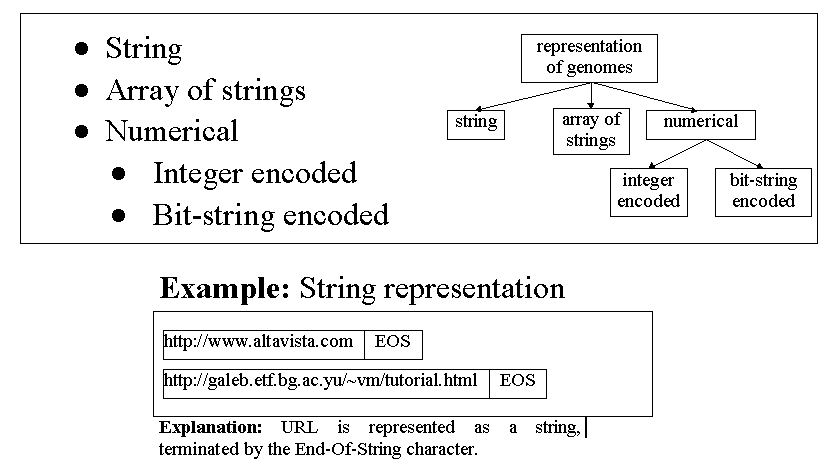
Crossover Operator
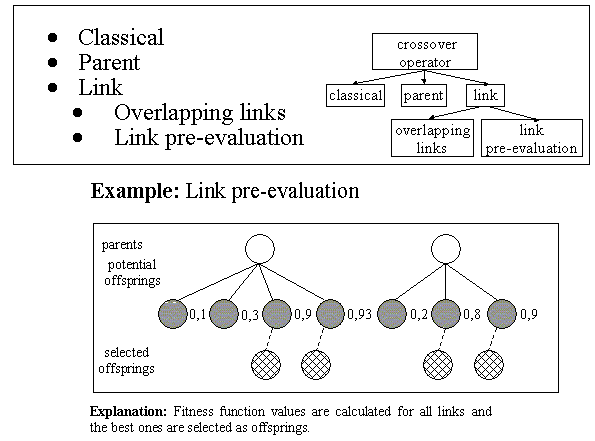
Fitness Function
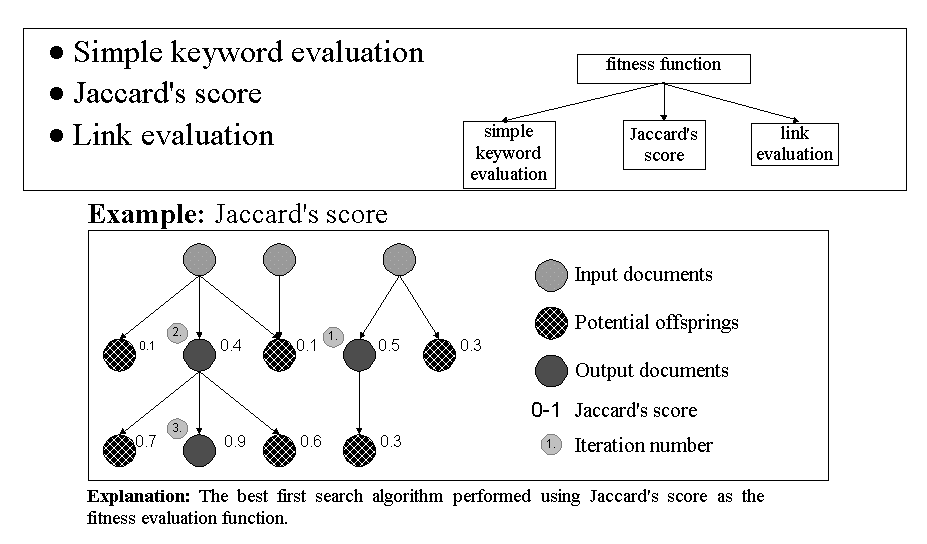
Degree of the Crossover
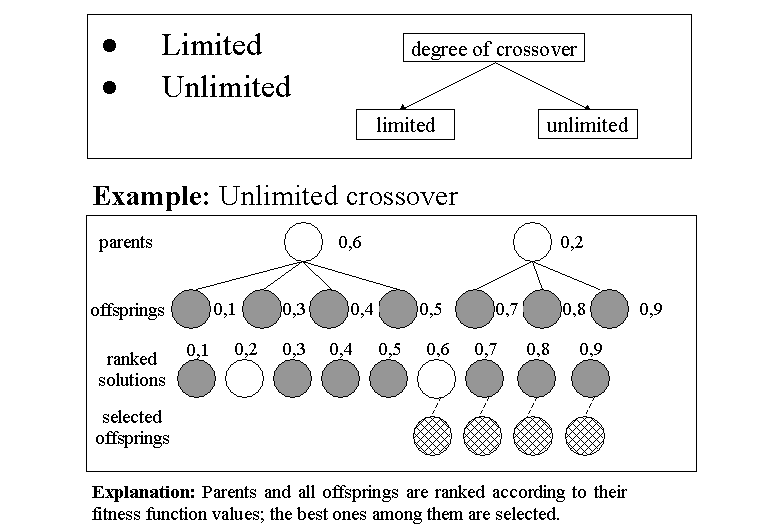
Mutation Operator
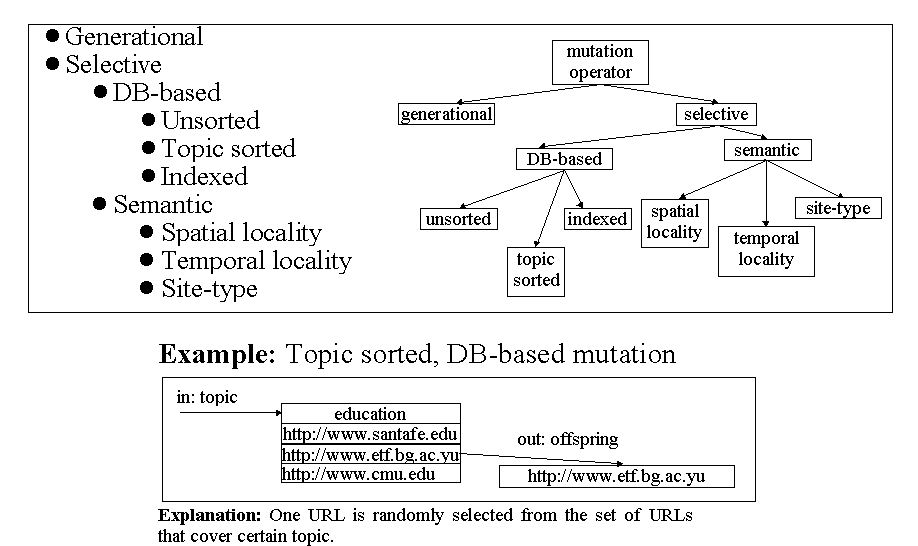
Generation of the Output Set
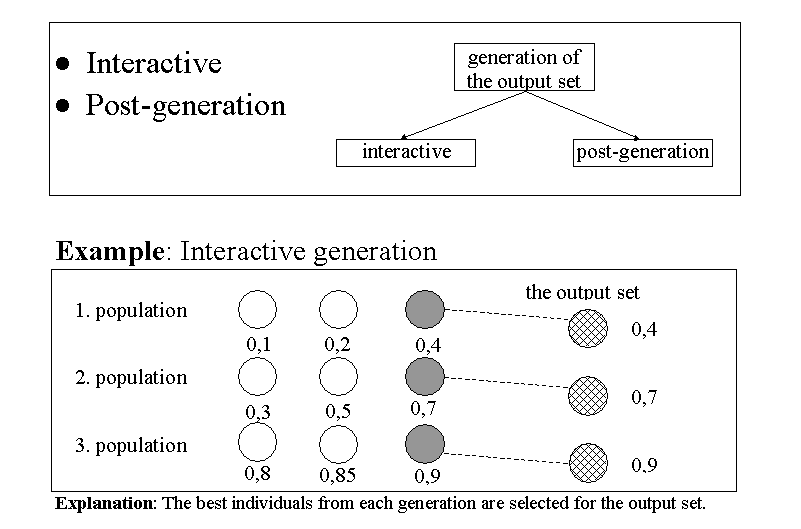
Selected Papers About Intelligent Agents on Internet
Chen, H., Chung, Y.-M., Ramsey, M., Yank C., Ma, P.-C., Yen, J.,
"Intelligent Spider for Internet Searching,"
Proceedings of the HICSS-97, Maui, Hawai'i, USA, pp. 178-188
.
This paper introduces a new interactive genetic search algorithm,
which is better than traditional genetic search without on-line adjustments
(the worst case of which is the best-search algorithm)
- The number of home pages is doubled every 6 months!
Consequently, searching is a challenge!!!
Intelligent searching agents are called "spiders."
- Major problems:
(a) Information overload
(b) Vocabulary differences (synonyms, different languages, ...)
- Main information retrieval mechanisms:
(a) Keyword search (Lycos at CMU and Yahoo at Stanford)
(b) Hypertext browsing (Mosaic and Netscape)
- Two main approaches to Internet searching:
(a) Client-based searching spider
(b) Server-based on-line database indexing and searching
- Client-based searching spiders:
(a) TueMosaic based on the Best First Search algorithm
(b) TueMosaic v2.42 based on the Fish Search algorithm
(c) WebCrawler based on an Improved Fish Search algorithm
- The Best First Search elements:
(a) Current homepage (one or a set)
(b) User specified set of keywords
(c) Depth and width of search for links contained in the current homepage
- The Fish Search - a modification of the Best First Search:
(a) Each URL corresponds to a fish
(b) After the document is retrieved, fish spawns children (URLs)
(c) These URLs are "produced" only if relevant (not unconditionally)
- Drawbacks of the Best First and the Fish Search:
(a) Potentially relevant homepages which do not connect with the current one
are inaccessible!
(b) The search is exponential, with the increase of depth and width.
- The Crawler Search - a modification of the Fish Search
:
(a) Search initiated using index
(b) Links followed in an intelligent order:
Relevance of a link is evaluated using the anchor test
Anchor test measures similarity between anchor text and user query
Anchor text are the words describing the link to another document
Anchor text is a small subset of the document
Search speed versus search quality
Essence: If weak links avoided - more strong links in unit of time!
(c) Used by America Online since January 1995
- On-line database searching and indexing:
(a) Entire WWW documents are retrieved and temporarily stored on the host server
(b) All relevant information is indexed on the host server
(c) This creates a server-based replica of all information on the WWW
(d) Index is used as a search key
- Examples:
(a) WWWW - World Wide Web Work
(b) AilWeb
(c) Harvest Information Discovery and Access System
(d) University of Arizona WWW Lab
(e) Lycos
(f) Excite
(g) Yahoo
(h) Alta Vista
- Architecture of an intelligent spider (5 components):
(a) Requests and control
(b) Graphical user interface
(c) Search engine
(d) Home page fetching
(e) Indexing source
- Requests and control (#1):
(a) Users submit queries with information such as
1. Starting URL(s)
2. Keywords
3. Number of URLs expected to return
4. Category of the searching space
(b) When a query is submitted
the appropriate searching space is invoked
in the available database
- Graphical user interface (#2):
(a) A link between the submitted query and the searching engine
(b) Important that users can view intermediate results
- Search engine (#3):
(a) Genetic algorithm
(b) Simulated annealing
- Homepage fetching (#4):
(a) Public fetching machines (Lynx and HtmlGobble)
(b) Custom fetching machines (Arizona and Serbia)
- Indexing score (#5):
(a) Major goal of indexing is to identify the contents of a WWW document
(b) Major procedures of indexing are
1. Word identification (ignored: case and punctuation)
2. Word filter (extracted: common function, pure, and general words)
- Comparing the similarity of homepages - Jaccard's score:
(a) A homepage with a higher Jaccard score has a higher fitness
with the input homepage
(b) Score computed from links or from indexing
Score From Links:
Homepages are x and y
Their links are X={x1, x2,...} and Y={y1, y2,...}
Jaccard's score between x and y is equal to:

If X=Y then J=1
If X<>Y then J=0
Reference:
Goldberg, D.E.,
"Genetic Algorithms in Search, Optimization, and Machine Learning,"
Addison-Wesley, Reading, Massachusetts, 1989.
Score From Indexing:
#1. Total number of homepages is counted - N
#2. Terms of a homepage are identified - set t
#3. Total number of terms is counted - L
#4. The number of words in term j is calculated - wj
#5. Term frequency number of occurences of term j in homepage x - tfxj
#6. Homepage frequency number of homepages in set N where term j occurs - dfj
#7. Combined weight of term j in homepage x - dxj





Details of the Best First Search Implementation:
Essence:
(a) Looking for the best homepage in each iteration
(b) The number of iterations is equal to the number of required homepages
- Algorithm:
(a) Initialization and input
#1. Initialize k to 1
#2. Obtain the initial set of homepages from the user(s)
#3. Homepages from the initial set are fetched
#4. Linked homepages of input set are saved in H={h1, h2, ...}
(b) Determining the best homepage in H:
#1. Determine the Jaccard's score for all elements of set H
#2. Score is computed as:



(c) Fetch the homepage from H with the highest JS
#1. Save it as OUTPUT(k)
#2. Increase k by 1
(d) Repeat until all output homepages obtained
Simulated Annealing for Internet Search
A discrete method for finding
the global minimum of a function.
Unlike in continuous methods,
no calculation of derivatives is needed.
By simulating the slow cooling process,
a local minimum can be found.
By simulating a sudden heating process
and stochastic crossover, conditions are generated
for a potentially more efficient minimum search.
As the number of iterations increase,
with a certain probability, the smallest minimum
can be declared equal to the global minimum.

Explanation:
Symbolic Representation of Simulated Annealing
SlC - Slow Cooling
SuH - Sudden Heating
StC - Stochastic Crossover

Explanation: Simulated Annealing on a MIMD Machine
The speed-up is considerably slower than linear [Green90],
due to quasi-minima created by partitioning and interprocess communications.
Important Difference Between SA and GA
SA - Single solution being modified over time (inherently serial)
GA - A population of candidate solutions maintained (inherently parallel)
Single search (typical of SA) is inherently serial
and therefore difficult to get parallelized.
However, it potentially offers a better performance, since no edge effects and interprocess communications are present [Chen98].
Consequently, a hybrid approach may be a solution!
Essence of the Hybrid Approaches
One solution maintained per processing element (PE).
Each PE accepts a solution from other PEs
for crossover and mutation.
If the best solution from the neighborhood is selected, convergence is potentially faster,
but serialization gets limited.
If all PEs receive the visiting solution
from the same direction, convergence gets slower,
but parallelization gets easier,
and enables an overcompensation.
GSA Algorithm Running on Each PE
of a MasPar Machine
1 begin
2 temperature:=_initial_temperature();
3 r:=_random_solution();
4 for i:=1 to max_iteration do
5 begin
6 direction:=random(0, 7, random_seed);
7 distance:=random(1, max_distance, random_seed);
8 v:=XNet_direction(distance).r;
9 [n0, n1]:=crossover_mutation(r, v);
10 r:=select(r, n0, n1, temperature);
11 temperature:= temperature *
a ;
12 end
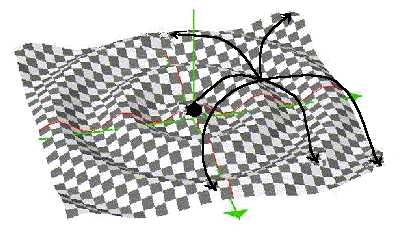
13 return r
14 end
References
[Chen98] Chen, H., Flann, N., Watson, D.,
Parallel Genetic Simulated Annealing:
A Massively Parallel SIMD Algorithm,
IEEE Transactions on Parallel and Distributed Systems,
Vol. 9, No. 2, February 1998.
[Green90] Green, D.,
Parallel Simulated Annealing Techniques,
Physica,
Vol. 42, pp. 293-306, 1990.
[Goffe94] Goffe, W., Ferrier, X., Rogers, X,
Global Optimization of Statistical Functions
with Simulated Annealing,
Journal of Econometrics,
Vol. 60, No. 1/2, January/February 1994, pp. 65-100.
An Intelligent Spider
Based on Hybrid Simulated Annealing
The Moore's law applies to Internet, too:
"Amount of information stored on Internet
doubles every 18 months."

Reference
Yang, C., Yen, J., Chen, H.,
"Intelligent Search Engine Based on Hybrid Simulated Annealing,"
Proceeding of the HICSS-98,
Kona, Hawaii, USA, January 1998, pp. 415-422.
Initialization
Take a set of input documents (HPs with URLs)
and save into the set named CurrentConfiguration (CC):
card(CC)=card(OutputSet)*2
Temperature T is initialized to a relatively large value.
Generation of New Configuration
Fetch the documents linked from the documents in the CC.
Compare their links with links of the documents in the CC.
card(CC)/2 documents that have the highest number
of overlapping links with the documents in the CC
will be saved in the set A.
card(CC)/2 documents are obtained from the database
in the user selected category, using the SWISH program,
and saved in the set B.
Jaccard's score is computed for each document in CC:

- Compute the average Jaccard's score of the documents in the CC:

For each document x in A or B
If

save the document in CurentConfiguration
Else if

where rand is a random value between 0 and 1,
save the document in CurentConfiguration
Decrease the temperature T,
and repeat the same procedure
until T reaches a certain value,
or the change of Avg is less than a threshold.
An important research trend:
Intelligent agent research (e.g., HICSS-98)
Major Industrial Research in the USA
- OpenGroup: MOA,
- IBM: Aglet,
- Crystaliz: MuBot,
- General Magic: Telescript + Odyssey.
- For more information: AltaVista or EBI
Research at University of
Belgrade

Specification of the KQML
Agent-Communication Language
(Stanford University)
- Message-passing is glue that builds large software systems
out of smaller software systems. - Many new standards and toolkits supporting the transport of messages among programs
(e.g., OMG CORBA, OSF DCE, ISIS, BSD Sockets, even ServiceMail),
but once connected, what should programs say to one another? - Sophisticated programs, especially knowledge-based "agents,"
interact in may ways beyond the simple query-response paradigm of standards like SQL, leading to a proliferation of incompatible agent communication languages.
- Knowledge Query and Manipulation Language (KQML).
KQML is a language that programs can use to describe a variety of different attitudes about information including queries, assertions, action requests, information subscriptions, and processing capabilities.
- Furthermore, KQML is an enabler of information-flow architectures,
though forwarding, broadcasting, and brokering messages.
http://www.sce.carleton.ca/faculty/bieszczad/courses/94587/AgentBasedEngineering.html
Agent-mediated Electronic Commerce: A Survey
(MIT)
Software agents are programs to which one can delegate (aspects of) a task.
They differ from “traditional” software in that they are personalized, continuously running and semi-autonomous.
Consumer Buying Behavior Model:
Need Identification
This stage characterizes the consumer becoming aware of some unmet need.
Within this stage, the consumer can be stimulated through product information.
Product Brokering
This stage comprises the retrieval of information to help determine what to buy.
Encompasses the evaluation of product alternatives based on consumer-provided criteria.
The result of this stage is called the “consideration set” of products.
Merchant Brokering
This stage combines the “consideration set” from the previous stage
with merchant-specific information to help determine who to buy from.
This includes the evaluation of merchant alternatives based on consumer-selected criteria
(e.g., price, warranty, availability, delivery time, reputation, etc.).
Negotiation - this stage is about how to determine the terms of the transaction.
Purchase and Delivery - self-explanatory
Product Service and Evaluation - this post-purchase stage involves product service, customer service,
and an evaluation of the satisfaction of the overall buying experience.
http://www.iiia.csic.es/amet98/abstract5.html
The Oz Project
Carnegie Mellon University
Oz - a computer system for creation and presenting higly interactive dramas (Bates 92).
Highly interactive - the interactor is choosing what to do, say, and think at all times.
Drama - even though the interactor is choosing what to do, say, and think, there is a destiny,
created by the author of the interactive drama.
Two different presentation models: textual and animated
The textual system uses text as the input and output medium. The world and characters are described through text,
and the interactor's actions are entered to the computer through text.
In the animated system, the world and characters are presented graphically.
Humans interact with the system physically, through sonar sensors and a mouse.
In the future of both systems, people may interact through sounds and speech

- The architecture includes a simulated physical world, several characters, an interactor, a theory of presentation,
and a drama manager. A model of each character's body and of the interactor's body are in the physical world.
Outside the physical world, a model of mind controls each character's actions. The interactor's actions are controlled by the interactor. Sensory information is passed from the physical world to the interactor through an interface controlled by a theory o
f presentation. The drama manager influences the characters' minds, the physical world, and the presentation theory.
http://128.2.242.152/afs/cs.cmu.edu/project/oz/web/oz.html
The Edgar Agent
(University of Kansas and Rutgers University)
Example of an intelligent agent that gathers financial information.
Used mostly in auditing - value added service of the auditor.
Organizations need to know (in real time) how they perform!
Simple internals - written in Perl. (UNIX scripting language)
Uses the Berkeley Sockets Lib and the Steven Brenner CGI Lib.
Learning while searching!

Nelson, K., et al,
Virtual Auditing Agents: The Edgar Agent,
Minitrack on Enabling Technologies,
The Internet and the Digital Economy Track,
Proceedings of the HICSS-98, Kona, Hawaii, USA, January 1998.
The IIR Agent
(National Taiwan University)
A solution for the information overload problem (category~directory).
An agent community is proposed (to suggest interesting
URLs to visit).
Agents and subagents based on knowledge categories (community architecture).

Explanation:
The architecture of agent community
Tu, H.-C., et al,
An Architecture and Category Knowledge
for Intelligent Information Retieval Agents,
Minitrack on Enabling Technologies,
The Internet and the Digital Economy Track,
Proceedings of the HICSS-98, Kona, Hawaii, USA, January 1998, pp. 405-414.
Browsing Agents for Improved Commerce (National Sun Yat-Sen University in Taiwan)
Five agent types:
recommendation, new-content, search, customizing, status
Essential elements: Control engine + knowledge base
Prototype: Book commerce


Lai, H., et al,
A System Architecture of Intelligent-Guided Browsing on the Web,
Minitrack on Enabling Technologies,
The Internet and the Digital Economy Track,
Proceedings of the HICSS-98, Kona, Hawaii, USA, January 1998, pp. 423-432.
A Decentralized Coalition Multi-Agent (University of Hong Kong)
Deregulation and restructuring in power industry
for better efficiency!
Agents assisting owners
(of power generation stations + transmission lines)
and customer groups
(in negotiations about contracts and coalitions).

Yen, J., et al,
Multi-Agent Coalition Formation in Power Transmission Planning,
Minitrack on Enabling Technologies,
The Internet and the Digital Economy Track,
Proceedings of the HICSS-98, Kona, Hawaii, USA, January 1998, pp. 433-443.
Bilateral Negotiation:
for each agent:
- Initially, set i = 1.
- Sends an offer to the ith agent
in the agent’s preference list, i.e. L(i).
- Waits for replies and offers from other agents.
If an offer from the agent L(j), j
£ i is received, i = j.
If an offer from the agent L(j), j > i or from an agent
outside the preference list L has been received, replies a dissent message to that agent. If no more offers from other agents have been received, replies a consent message
to agent L(j) and informs coordinator about the candidate coalition with agent L(j).
If a consent message from agent L(i) has been received, informs coordinator about
the candidate coalition with agent L(i). If a dissent message from agent L(i)
has been received and L(i) is not the last agent in the preference list,
i = i+ 1 and go to step 2.
for coordinator:
When coordinator receives messages from both founders of a candidate coalition,
it informs every agent to stop negotiation and removes from its own preference list
the agents within the candidate coalition, and then goes to step 2.
When every agent reaches the end of the list L and no coalition is possible, the process terminates.
An Agent for Resolving
the Multiagent Collaboration Dilemmas
(NTU, Taiwan)
- Proposing a set of general quantitative criteria (agent Ana meets agent Bob)
for detecting collaboration cases (open motives and motives behind),
and for picking strategies to maximize effectiveness (FT in achieving goals).
- Definition (Collaboration payoff):
Given R1, ... , Rn over a scalar field F (e.g. real numbers) as resources invested in a collaboration by an agents a1, ... , an respectively, the payoffs to agent ai, i=1, ... , n,
of the collaboration is a function pi(R1, ... Rn)Î F.
- Definition (Agent collaboration problem):
Given a set of agents about to participate in a (possibly infinite)
sequence of collaborations, a solution to the agent collaboration problem (ACP)
for each paticipating agent is an algorithm that decides
a sequence of resource contribution decisions to maximize
the agent’s accumulated profit during the collaborations.
Wang, J. C.-C.,
A Framework for Resolving the Multiagent Collaboration Dilemmas,
Minitrack on Enabling Technologies,
The Internet and the Digital Economy Track,
Proceedings of the HICSS-98, Kona, Hawaii, USA, January 1998, pp. 444-451.
An Agents for a Kiosk
(University of Hong Kong)
- Architecture of an agent-based society:
Communications procedures and control policies.
- Case study: Tourism kiosk for Hong Kong.

Yeung, C.,
A Multi-Agent Based Tourism Kiosk on Internet,
Minitrack on Enabling Technologies,
The Internet and the Digital Economy Track,
Proceedings of the HICSS-98, Kona, Hawaii, USA, January 1998, pp. 452-461.
An Agent System for Information Infrastructure Management (GMD)
- Use of Java-based agents
in network and service management.
- Essential issue:
Platform supporting agent mobility, to compare with
OpenGroup MOA, IBM Aglet, Crystaliz MuBot, General Magic Telescript + Odyssey.

Covaci, S.,
Mobile Intelligent Agents
for the Management of the Information Infrastructure,
Minitrack on Agent Mobility and Communication,
The Software Technology Track,
Proceedings of the HICSS-98, Kona, Hawaii, USA, January 1998, pp. 24-33.
An Agent System for Security Issues
(Darmstadt University of Technology)
- Safety versus security!
- Issues of interest:
A-to-H, A-to-A, H-to-H, and H-to-A security

Fuenfrocken, S.,
Integrating Java-Based Mobile Agents into Web Servers
Under Security Concerns,
Minitrack on Agent Mobility and Communication,
The Software Technology Track,
Proceedings of the HICSS-98, Kona, Hawaii, USA, January 1998, pp. 34-43.
The Agent for Tracking Agents
Agent identification, creation, cloning, and deletion
Message handling
Algorithms for agent migration and tracking
The migration for tracking algorithm:
- send a message Update Entry to the local commu-nication agent
with the target address;
- send a message AgentIsMigrating to the target communication agent
informing it to buffer all incom-ing messages forwarded to the migrating agent;
- in the local database, mark the agent’s address with the tag Migrated;
- wait for all active threads to terminate;
- remotely clone the agent on the target node passing as arguments
to the creator agent the agents’s id and the variable NumberOfHops
(an integer giving the number of migrations made by the agent
up to the current node; its value defaults to 0 and is incremented
each time a migration occurs);
- forward all messages left in the mailbox to the newaddress and flush the mailbox.
Desbiens, J., et al,
Communication and Tracking Infrastructure of a Mobile Agent System,
Minitrack on Agent Mobility and Communication,
The Software Technology Track,
Proceedings of the HICSS-98, Kona, Hawaii, USA, January 1998, pp. 54-63.
Agents for Improving Interagent Communications
(University of Karlsruhe)
Providing an infrastructure for remote interagent communication
and for locating agents during their remote execution.
Basic messaging/directory mechanisms do not scale up (so: multicast IP layer)


Hartroth, J., et al,
Using IP Multicast to Improve Communication
in Large Scale Mobile Agent Systems,
Minitrack on Agent Mobility and Communication,
The Software Technology Track,
Proceedings of the HICSS-98, Kona, Hawaii, USA, January 1998, pp. 64-73.
An Agent for Adaptive Routing
(Universite' Libre de Bruxelles)
Introducing AntNet - A distributed mobile-agents-based algorithm
inspired by the ant colony metaphor to achieve efficiency
(ant agents sit at nodes and make local research when asked to do so)

Di Caro, G., et al,
Mobile Agents for Adaptive Routing,
Minitrack on Agent Mobility and Communication,
The Software Technology Track,
Proceedings of the HICSS-98, Kona, Hawaii, USA, January 1998, pp. 74-83.
Research at UB/IFACT
Two major research domains:
Algorithmic domain:
mutation based on spatial and temporal locality
[Milutinovic+Kraus97]
Open problems:
spatial node switch function and temporal page revisit period
Tools domain:
software packages supporting the Lego approach
to Internet experimenting
Open problems:
interface issues and resource absorption
Acknowledgments:
Laslo Kraus, Jelena Mirkovic, Sasa Slijepcevic, Nela Tomca, etc…
The XML (Extensible Markup Language) Standard
Aprroved by W3C (WWW Consortium)
Based on SGML (Standard Generalized Markup Language)
HTML determines only the way in which browser displays the document
XML also defines contents (using tags), for more efficient search
HTML has a fixed set of tags
XML is a metalanguage to desing one's own ML and special tags
HTML handles complex DTDs only via CGI scripts and Java applets
XML handles complex document type definitions via language constructs
Clark, D., W3C Approval Gives XML a Push,
IEEE Computer, April 1998, pp. 18-19.





































